RADIOS and SYSTEMS IN HALIFAX CLASS FRIGATES
The Canadian Patrol Frigate project began in 1977.
Planning, designing, building and delivering operational warships is a
long and complex process. In 1983, the federal government approved the
budget for the design and construction of six new frigates. The contract
was awarded to Saint John Shipbuilding Limited (SJSL). In 1987, construction
began on the first ship, HMCS HALIFAX.
It soon became obvious that the original deadlines could not be met.
SJSL proposed a new strategy to maximize the amount of pre-outfitting of
the erection units before they were joined in the drydock. This approach
reduced construction costs and improved quality, but it required more detailed
engineering before construction could begin. The delivery dates for the
first two ships had to be delayed.
In 1986, Versatile Corporation, whose Montreal firm, Versatile Vickers,
held the sub-contract for the building of three frigates, began to experience
financial difficulties. In 1987, Versatile was replaced by Marine Industries
Limited. By 1987, the White Paper on Defence was published, outlining a
total modernization plan for the Canadian Forces, including procurement
of an additional six frigates. The CPF contract was amended accordingly.
As a result the frigates were built in two batches of six each sometimes
referred to as the 'Montreal' and 'Halifax' batches. All the ships are
named after Canadian cities.
On September 28, 1996, HMCS Ottawa, the last of the twelve Halifax Class
patrol frigates was commissioned into the Canadian Navy thus completing
a new class of Canadian warship.
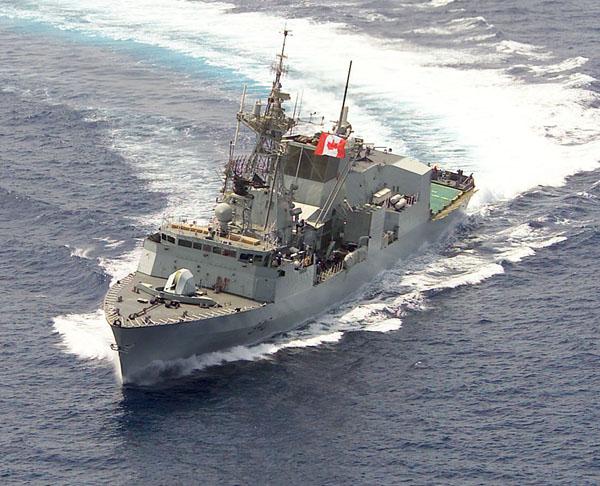 |
| HMCS St. John's is executing a hard turn. Taken in 2002, the ship was
operating in and around the Gulf of Oman as part of Operation APOLLO, Canada's
military contribution to the international campaign against terrorism.
(Photo
by: MCpl Michael Durand, Formation Imaging Services, Halifax) |
|
VITAL STATISTICS
|
Displacement: 4,750 tonnes
Dimensions: Length 440' x Beam 53'8" x Draught 15'1
Speed: 30+ knots
Endurance: 7,100 nm at 15 knots (diesel)
4,700 nm at 15 knots (gas)
Machinery: 1 Pielstick Model PA6, 20 cylinder cruise diesel. (10,000
SHP)
2 GE LM 2500 gas turbines; (50,000 SHP) 2 shafts
Twin Inward Turning Controllable Reversible Pitch.
Crew : 229 |
Helicopter: One CH-124 Sea King
Torpedoes: Honeywell Mk 46 Mod 5 (Ship or Helicopter launched)
Missiles: 16 Raytheon Vertical Launched Sea Sparrow (surface to air).
8 Boeing Harpoon (surface to surface)
Guns: One 57mm Bofors MK2
One Vulcan Phalanx
MK 15 20 mm Close-In Weapons System (CIWS). Six .50 Calibre Heavy Machine
Guns |
Power is generated by four diesel generator sets which supply
two electrical switchboards. Each of these generators are mounted in individual
acoustic enclosures, and are located in the auxiliary machinery rooms,
two forward and two aft. The separation of these generators ensure that
one or more will remain operational despite battle damage occurring to
a section of the ship. These four diesels combine to provide up to 3.4
megawatts of power.
BUILDING PROGRAM
|
HALIFAX BATCH
|
| NAME |
PENDANT |
CALL SIGN |
LAID DOWN |
LAUNCHED |
COMMISSIONED |
| CALGARY |
335 |
CGAF |
15/6/1991 |
28/08/1992 |
12/05/1995 |
| HALIFAX |
330 |
CGAP |
19/3/1987 |
30/04/1988 |
29/06/1992 |
| REGINA |
334 |
CGAE |
6/10/1989 |
25/01/1992 |
29/12/1993 |
| TORONTO |
333 |
CGAD |
22/4/1989 |
18/12/1990 |
29/07/1993 |
| VANCOUVER |
331 |
CGAR |
19/5/1988 |
8/07/1989 |
23/08/1993 |
| VILLE de QUEBEC |
332 |
CGAC |
16/12/1988 |
16/05/1991 |
29/03/1993 |
|
MONTREAL BATCH
|
| CHARLOTTETOWN |
339 |
CGAJ |
18/12/1993 |
1/10/1994 |
9/9/1995 |
| FREDERICTON |
337 |
CGAN |
25/4/1992 |
26/6/1993 |
10/9/1994 |
| MONTREAL |
336 |
CGAG |
9/2/1991 |
26/2/1992 |
21/7/1994 |
| OTTAWA |
341 |
CGAL |
29/4/1995 |
4/5/1996 |
28/9/1996 |
| ST. JOHN'S |
340 |
CGAK |
24/8/1994 |
26/8/1995 |
24/6/1996 |
| WINNIPEG |
338 |
CGAI |
20/2/1993 |
5/12/1993 |
23/6/1996 |
WEAPON SYSTEMS
* Combat data system: SHINPADS combat management system
* Helicopter: 1 x CH 124A Sea King
* Surface to air missiles: Sea Sparrow
* Surface to surface missiles: Harpoon
* Guns: Bofors 57mm/70 Mk 2 GWS. 220 rounds per minute to a height
of 17 km (9 nm)
* Close in weapon system: Phalanx
COUNTERMEASURES
* Electronic support measures: CANEWS
* Electronic countermeasures Ramses: AN/SLQ-503
* Chaff and IR flare decoy: Shield decoy launcher
* Torpedo decoy: AN/SLQ-25 Nixie towed decoy
RADAR
* Air search: Raytheon SPS-49(V)5 long range air search radar operating
in the C/D bands.Capable of detecting
a 2 meter target at 457 km and tracking 250 targets.
* Medium range search: Ericsson SPS 505 Sea Giraffe 150 HC/CPF. G and
H bands. It provides cover against low flying aircraft and missiles in
conditions of heavy 'clutter' to a range of 55 nm (100km).
* Fire control: Two Thales Nederland (formerly Signaal) SPG-503
(STIR 1.8) fire control radars are installed – one on the roof of the bridge
and one on the raised radar platform immediately forward of the helicopter
hangar.
* Navigation: Kelvin Hughes Type 1007 . I band (may now be upgraded)
* IFF: Hazeltine APX-72 Mk XII Transponder
SONAR
GD-C = General Dynamics Canada formerly Computing Devices of Canada
* GD-C CANTASS Canadian Towed Array;
* GD-C AN/SQS-510 Hull Mounted Sonar;
* GD-C AN/UYS-503 Sonobuoy Processing System
In April 2006, the Canadian navy placed an order for 13 Sirius
long-range Infrared Search and Track (IRST) systems with DRS Technologies
Canada and Thales Nederland as major subcontractor. Sirius is a dual waveband
(3-5 and 8–12 micron) surveillance system. Twelve systems are destined
for the Halifax frigates and one for land-based training. The systems will
be delivered between 2008 and 2011.
ELECTRONICS MANIFEST
This original equipment manifest reflects the comms fitting when these
ships entered service in the 1990's and was provided by the Canadian Navy.
As of early 2007, it is not known how much of this equipment is in service,
however it does represent an accurate snapshot of the way it was in the
beginning. This list does not indicate the quantity of each piece of communications
gear carried aboard each ship. Because the ships were built in two batches
any upgrades are also also done on a two-batch scheduling system so their
electronics fir may not be identical at any given time. As a result, the
Halifax and Montreal batches do not look identical in all respects. This
is the way it was explained by a CPF project engineer.
NATO
DESIGNATION |
EQUIPMENT
DESIGNATION |
FUNCTION |
RANGE (MHz) |
MANUFACTURER |
| AN/SRT504 |
T 5086A/URT |
HF Transmitter |
1.5 - 30 MHz |
Harris |
| AM-5443/URT |
| AS-3772/AU |
Whip Ant (35 ft) |
5.5 - 15 MHz |
CHU Associates [11] |
| AS-5199/U |
HF Fan Antenna |
2 - 6 MHz |
Eldyne [14] |
| AS-3770/AU |
Whip Antenna |
11 - 30 MHz |
CHU Associates |
| |
R-5095 B/G |
RF Harris Receiver |
10 KHz to 30 MHz |
Harris |
| RF-1985 |
HF Antenna |
.01 - 30 MHz |
Harris |
| R-5080/SRR |
LF Distress Rcvr |
500 KHz .(Obsolete as of 1999) |
Redifon [13] |
| R-5081/SRR |
HF Distress Rcvr |
2.182 KHz |
Redifon |
| AN/SRC 514 |
RT 5073/WSC3 |
UHF LOS Transceiver [5] |
225 - 400 MHz |
E-Systems |
| AS-5169 |
UHF LOS Antenna |
225 - 400 MHz |
Sinclair |
| AN/SRC 515 |
RT 5073/WSC3 |
UHF Emergency Receiver |
225 - 400 MHz |
E-Systems |
| R 5113/SRR |
UHF LOS Distress |
243 MHz |
Redifon |
| OE-82C/WSC-1 |
UHF Satcom Antenna |
240 - 318 MHz |
Datron [10] |
| AN/SRR 1A |
AS 2815/SRR |
UHF Satcom Broadcast
receive antenna |
249 - 259 MHz |
Motorola |
| AN/SRC 509 |
RT 5056 |
VHF Maritime Mobile
transceiver |
156 - 163 MHz |
Sinclair |
| AS 5170 |
VHF Whip Antenna |
148 - 174 MHz |
Sinclair |
| AN/VRC 512 |
RT 246A/VRC |
VHF Land Forces
Support Transceiver |
30 - 76 MHz [1] |
E-Systems |
| AS 1729 |
VHF Antenna |
30 - 76 MHz |
E-Systems |
| AN/PRC 520 |
RT 5095/PRC |
VHF Tactical Portable
Transceiver |
151 - 164 MHz |
Motorola |
| SLR-225-HD |
VHF Antenna |
148-174 MHz |
Sinclair |
|
AN/ARR 75
|
|
VHF Sonobuoy
Receive System |
162-173 MHz.
31 simultaneous receive channels |
Edmac |
| AN/URN 25 |
|
TACAN |
962 - 1215 MHz |
NavCom |
|
AN/SRD-502
|
|
DF Set; migration towards "netted" shipboard DF radiolocation system |
References to AN/SRD-503 and 504 have been noted on the
web. |
Southwest
Research |
| AN/SPN 501 |
LC360 |
Integrated Loran-C/GPS receiver |
[3] |
Internav [12] |
| |
|
|
|
| AN/SRN 502 |
Omega II |
Omega Receiver |
0.01 [2] |
Tracor |
| -- |
VX3 |
Entertainment Receiver |
AM/FM |
Sony |
| -- |
SR-20 TA |
Entertainment Antenna |
AM/FM |
Wingard |
| -- |
KV 1114 |
Trinitron TV Receiver |
VHF/UHF |
Sony |
| AN/APX-72 |
RT-859A/APX-72 |
Mk XII IFF Transponder |
L-band. Rx- 1090 MHz; Tx 1030 MHz |
Hazeltine |
| -- |
AS-2188 |
IFF Interrogator Antenna for SPS-49(V)5 |
|
Hazeltine |
| -- |
AS-2694 |
IFF Interrogator Antenna for SPS-505 |
|
Hazeltine |
| -- |
1007 |
Navigation radar |
I Band |
Kelvin-Hughes [15] |
|
AN/SLQ-505
|
|
Radar jammer |
|
Thorn (now Thales) and Lockheed Martin Canada. |
|
AN/SLQ-25A
|
|
NIXIE Towed Acoustic Decoy |
|
Argon ST (formerly Sensytech) |
Naval Communicators
In the Frigates , the Communications section is the result of the amalgamation
of the old Naval Signalmen and Naval Radio Operators. This new section
provides one stop shopping for all the ship's communications needs. The
Naval Communicator section is responsible for setting up and maintaining
all operational circuits, transmitting and receiving inter-ship and ship-shore
messages, and distributing messages to command and various other departments.
They are also responsible for encoding and decoding tactical signals, for
all visual signalling, for shipboard ceremonial procedures, and for the
maintenance of all computer software and information technology hardware.
At one time, amateur radio was the main method of providing personal
communications for ship's crew but new technology has now changed all that.
The amateur radio station has now faded away as a viable means of communication.
Bob Canning of the Canadian Navy explains. "When someone is posted for
sea duty, they are given a DND E-mail account which gives them 24 hour
by 7 day satellite Internet access. This is very convenient for e-mailing
loved ones, relatives and keeping in touch. Voice Over IP (VOIP)
phones are also found aboard ships but are primarily used for business.
Ocassionally they are used for short calls home but only when absolutely
necessary.
Each ship issues phone cards to crew for personal use. Personnel
sign up for 15 minutes at a time on the phone cards. When the alottment
is exhausted, they have the card re-activated. This ensures that everyone
will get equal phone time. The phone cards are used with the "MINI-M"
phones, which is the name on the phone . These are separate from the VOIP
phones and ships usually carry three of them. Everyone onboard just calls
them Quality of Life phones because they help to provide a better quality
of life aboard ship.
Satellite Internet links, ranging from 128 kbps to 512 kbps, are fitted
in the the Halifax Class frigates. There are at least 5 telephone lines
assigned to IP phone service in Halifax which are available on a 24 hour
by 7 day basis regardless of where the ship is sailing in the world".
RADAR ANTENNAS
 |
| Halifax Class radar suite. (FC= Fire control). The primary weapon against
airborne targets is the semi-active guided Sea-Sparrow missile. It homes
on targets illuminated by one of two Separate Tracking and Illuminating
fire control radars (STIR). Electronic countermeasures such as RAMSES,
and Shield II chaff/IR decoys provide soft kill capability by decoying
enemy missiles away from the ship. If the target penetrates the above defences,
the Vulcan Phalanx CIWS is used. (Graphic courtesy Cnadian Navy Industry
Day presentation) |
SONAR
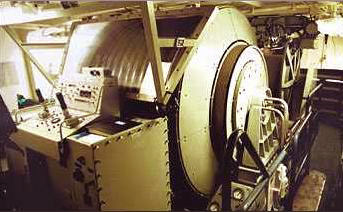 |
| AN/SQR-501 CANTASS. This is a passive, critical angle, towed array
sonar system. The system provides frequency and bearing analysis
of acoustic emissions at long ranges. (Photo and copy courtesy
Canadian Navy) |
 |
| This is the dome for the hull mounted AN/SQS-510 sonar. It is a medium
frequency (2 to 8 KHz) active sonar and is optimized for performance in
three specific scenarios: shallow water submarine detection, mine avoidance
and torpedo detection. The range is 1,835 to 55,045 metres. (Photo
and copy courtesy Canadian Navy) |
SYSTEMS
 |
CANEWS. AN/SLQ-501. The Canadian Electronic
Warfare System (CANEWS) is the ESM system used by the Canadian Navy.
This system was introduced into the Canadian Navy as part of the Destroyer
Life Extension (DELEX), TRIBAL Class Update and Modernization (TRUMP) and
Canadian
Patrol Frigate (CPF) programs. (Photo and copy courtesy Lockheed
Martin) |
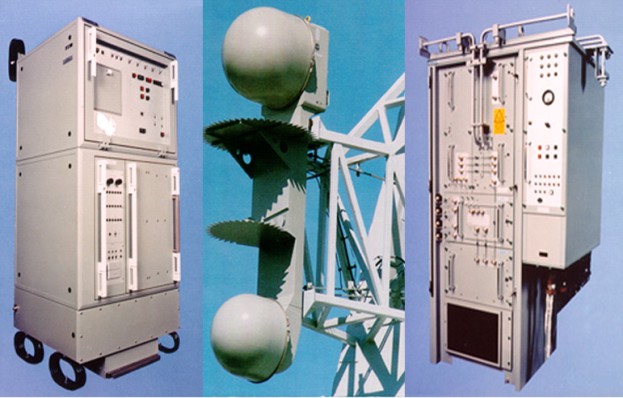 |
RAMSES. AN/SLQ-503. The Reprogrammable
Advanced Multimode Shipboard Electronic Countermeasures System (RAMSES)
[6] is deployed on the HALIFAX Class frigates RAMSES has a multi-target
capability and provides a range of jamming techniques to counter
all stages of missile attack.
(Photo and copy courtesy Lockheed Martin) |
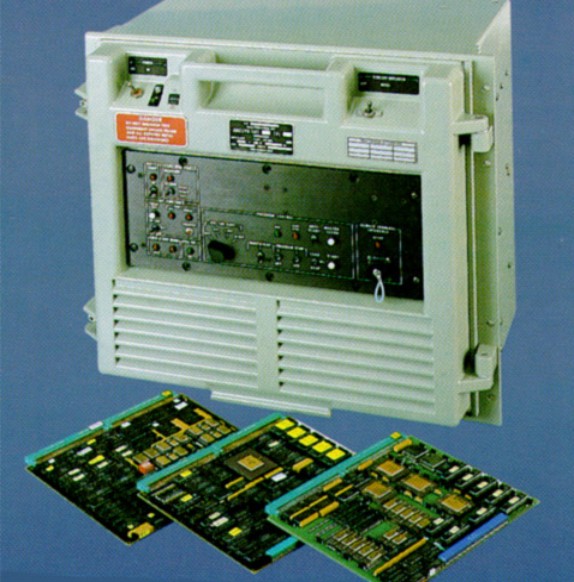 |
The AN/UYK-507 is a fully militarized
naval mission computer that serves as the heart of the HALIFAX Class frigate
command and control system. The SHINPADS [8] data bus is a fault tolerant
data bus, with separate command and data channels, that interconnects the
HALIFAX Class frigate distributed processing architecture. (Photo and
copy courtesy Lockheed Martin) |
xwave,[7] a trusted partner of the Department of National Defence
for over 20 years, provides some additional background on CANEWS.
"Under contract to Lockheed Canada, xwave developed the software
for this state-of-the-art Electronic Support Measures (ESM) System. CANEWS
identifies and classifies emitted radar signals for threat detection and
warning purposes. The system is fitted to all Canadian frigates and destroyers
including the Tribal Class Update and Modernization Program (TRUMP) ships
and the Canadian Patrol Frigates. The system is comprised of two AN/UYK-505
computers, a SHINPADS [8] standard display and radar receiver and interfacing
equipment. Software for CANEWS is written in CMS-2M and Ultra-16 in a VMS/HOST-16
development environment.
Developments under-taken by xwave were primarily for human-machine
interface, signal- processing algorithms, and interface to Command and
Control systems.
The Department of National Defence and Lockheed Canada are also in the
development of an interim Advanced Development Model, the next generation
maritime ESM system. This development, CANEWS-2, is focused on the design
of a system architecture, design of a hardware test bed, and the specification
and implementation of a suite of signal processing algorithms. CANEWS-2,
as currently implemented, forms a functioning ESM prototype consisting
of a multiprocessor hardware suite and signal-processing software".
OPERATIONS
 |
| Command and Control System 330 (CCS330) named after the lead ship in
the class. This system integrates the various detection systems, weapons
platforms, and communication systems with sophisticated multi-purpose computers
to detect, track, and engage all hostile threats. Only 15 out of the 28
tactical computers are shown in this graphic.
The International Systems web page offers this additional information
. "The SHipboard INtegrated Processing And Display System (SHINPADS) is
a Canadian Forces Trademark and is not really a system. Rather, it is rather
a concept of ship integration—not combat system integration or propulsion
and machinery system integration but ship integration. It encompasses
the entire ship system including all combat system equipments, marine engineering
systems, and extending into administrative support hardware. Other
aspects of the concept include standardization of hardware, software, and
interfacing". (Graphic courtesy Canadian Navy Industry Day Presentation) |
The SHips INtegrated COMmunication system (SHINCOM) employs
digital technology to integrate and control internal and external communications
systems. The SHINCOM system enables the patrol frigate to utilize voice,
radio, data link, and satellite communications, as well as providing an
effective way to communicate with other ships in company and within the
ship.
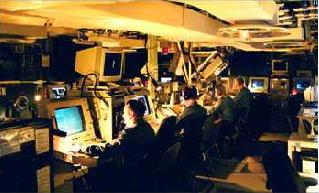 |
| Halifax class Operations Room. (Image courtesy Canadian Navy) |
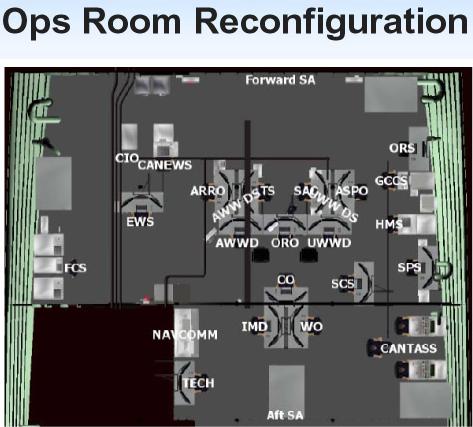 |
| This is a proposal to reconfigure the Ops Room in Halifax class ships.
Taken from a November 2006 Canadian Navy Industry Day presentation. (Graphic
courtesy Canadian Navy) |
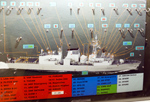 |
This image reflects Toronto's outfit during her
Operation Artemis deployment to the Arabian Sea. Included is SIRIUS,
the muzzle velocity radar on her new 57 mm Mk.3, gun and perhaps a few
other goodies. This board was on display in the main flat, so there
is nothing classified here. Click on image to enlarge. Can anyone confirm
if this a man aloft board? If so, please contact jerry.proc@sympatico.ca
(Photo by Sandy McClearn) |
OTHER PHOTOS
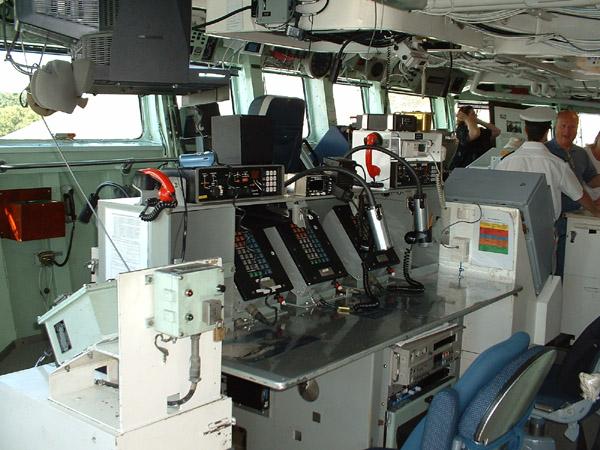
|
|
2005: HMCS Toronto. Port side view of bridge showing the signalman
position. The VHF radio on top of the console is a Sealand 66. (Photo
by Jerry Proc)
|
|
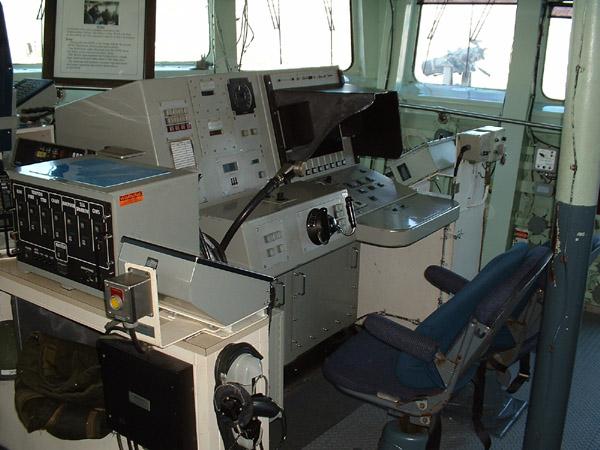 |
|
2005: HMCS Toronto. Helmsman's position. (Photo by Jerry Proc)
|
|
 |
| 2005: HMCS Toronto. Damage Control Board on the port side of the Machinery
Control Room. (Photo by Jerry Proc) |
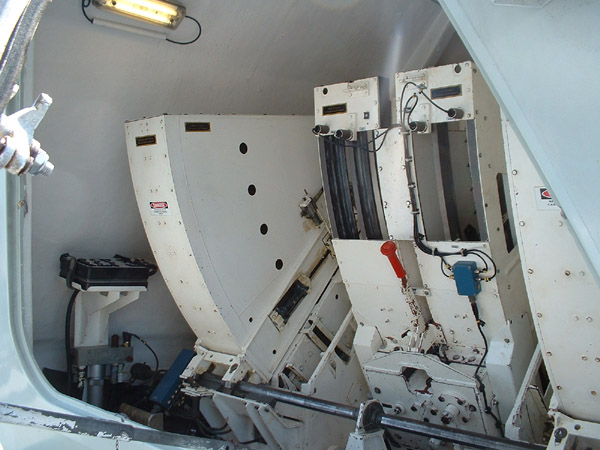 |
| Rear view of the 57 mm Bofors gun with the maintenance door opened
up. The locally-controlled operations panel is at the very
left. (Photo by Jerry Proc) |
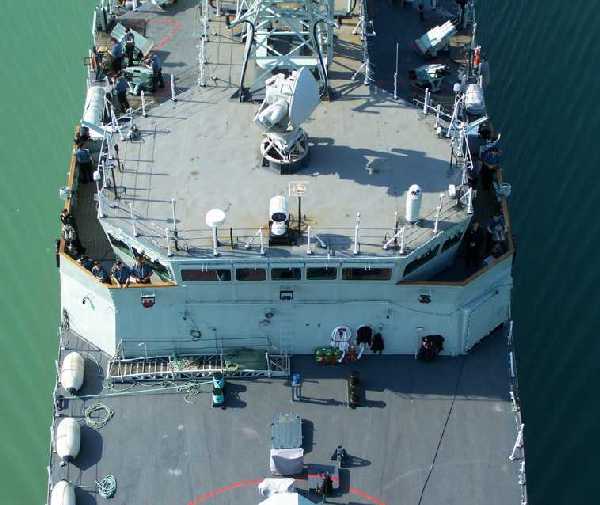 |
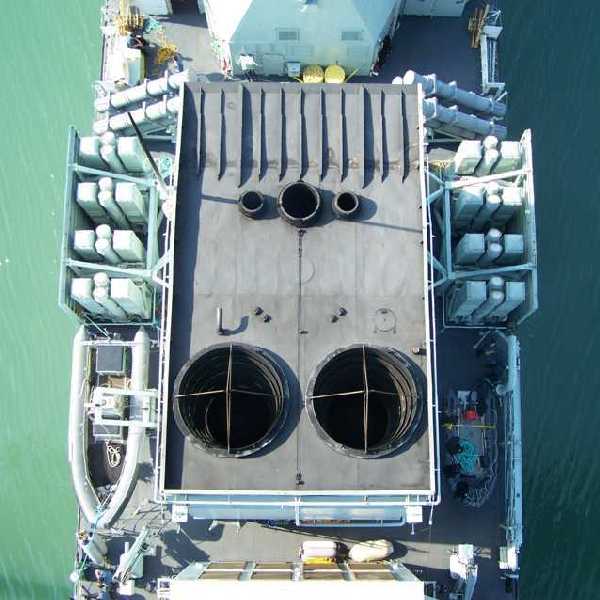 |
 |
| These rare aerial views were taken from a lift bridge as HMCS Halifax
made a transit of the Welland Canal in mid-May 2007. (Photo by Darren
Scannell) |
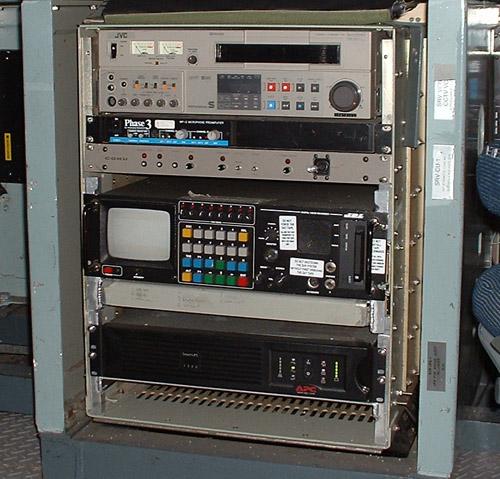 |
| This recorder is situated on the bridge and its purpose is to record
audio and video (people movement) on the bridge. Having such a device is
invaluable in case any situation needs to be analyzed in more detail.
(Photo by Jerry Proc) |
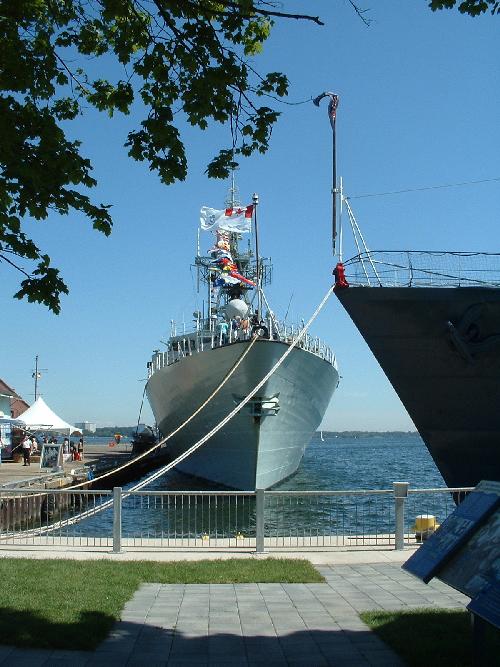 |
| Old Meets New. This is the scene at Pier 9 Hamilton on July
30, 2005 as HMCS Toronto is shadowed by HAIDA's distinctive Tribal bow.
(Photo
by Jerry Proc) |
FOOTNOTES:
[1] Waterway restricted to 30 - 50 MHz; 72 - 73 MHz; 75.2 - 76 MHz only.
[2] The Omega navigation system shut down worldwide in 1997.
[3] 100 KHz for Loran 'C' ; 1227/1525 MHz for GPS. Loran 'C' no longer
used for navigation in the Canadian Navy.
[4] Per Toronto Scientific and Surplus web page.
[5] LOS= Line of Sight
[6] RAMSES originally was developed by Hollandse Signaal Apparaten
(HSA) and was a joint development of HSA and MEL which were both Philips
defence industry companies.
[7] The company's name is all lower case.
[8] The International Systems web page offers this additional information
. "The SHipboard INtegrated Processing And Display System (SHINPADS) is
a Canadian Forces Trademark and is not really a system. Rather, it is rather
a concept of ship integration—not combat system integration or propulsion
and machinery system integration but ship integration. It encompasses
the entire ship system including all combat system equipments, marine engineering
systems, and extending into administrative support hardware. Other
aspects of the concept include standardization of hardware, software, and
interfacing".
[9] This sensor was added after 2001, during the Operation Apollo deployments.
Condor Systems Inc. declared bankruptcy in 2002. Their assets
were bought up by EDO Reconnaissance & Surveillance Systems.
[10] Datron became part of the Titan Group. Titan is now part of the
L-3 Communications group of companies. As of 2007, L-3 calls itslef
L-3 Communications Titan Group .
[11] CHU Associates is now part of the EDO Corp.
[12] Internav is located in Sydney N.S. Part of Randburg.com
[13] Now part of Thales.
[14] Acquired by Titan Corp. around 1996.
[15] This is a high definition surface and low altitude search and
navigation radar operating at 9,410 MHz, with an integral Automatic Radar
Plotting Aid (ARPA) function. It is believed that this radar type is now
superseded with other equipment.
Credits and References:
1) Marc Poitras <Marc.Poitras(at)gdcanada.com>
2) Lockheed-Martin http://www.lockheedmartin.com/wms/findPage.do?dsp=fec&ci=16965&rsbci=0&fti=0&ti=0&sc=400
3) Canadian Navy Day Presentation November 15, 2006.
Ottawa Ont. on-line PPF file
4) Frigate Building Program. HMCS Halifax.
Toronto http://www.navy.forces.gc.ca/halifax/about/ship_about_e.asp
5) Cadillac of Destroyers by Ron Barrie and Ken
Macpherson. Vanwell Publishing. St. Catharines, Ont. 1996.
6) HMCS Toronto http://www.navy.dnd.ca/toronto/about/ship_about_e.asp?category=35
7) Ships Dates reference. Wikipedia. http://en.wikipedia.org/wiki/HMCS_xxxxxx
8) Ships Dates reference. Aye Readye Aye http://www.readyayeready.com/cgi-bin/query/display.pl?index=1172
9) Shinpads http://www.usfamily.net/web/labenson/SystemsInternational.htm
10) Pat Barnhouse <pat.barnhouse(at)sympatico.ca>
11) Naval Communicartors http://www.navy.dnd.ca/ottawa/departments/ship_departments_e.asp
12) SRD502/3 - http://www.swri.org/3pubs/ar1998/sigexp.htm
13) Dave Shirlaw <djshirlaw(at)shaw.ca>
14) Canews Info http://www.xwave.com/files/credentials/electronic_warfare.pdf
15) Various Halifax-class photos http://www.navy.forces.gc.ca/cms_fleet/fleet_e/fleet-home_e.asp
16) Nixie http://www.naval-technology.com/projects/halifax/
17) Sensor Information - Naval Technology web page.
http://www.naval-technology.com/projects/halifax/
18) Canadian Warships since 1956, Roger G. Steed. 1999,
Vanwell Publishing. St. Catharines Ont.
19) Bob Canning <canning.m(at)forces.gc.ca>
20) David Blazenko <Blazenko.DM(at)forces.gc.ca>
21) Darren Scannell <hawkone(at)hawk-graphics.com>
22) Alexander (Sandy) McClearn <smcclearn(at)gmail.com>
Additional credits and references in each sub-section.
Back to Table of Contents
Feb 24/15



















